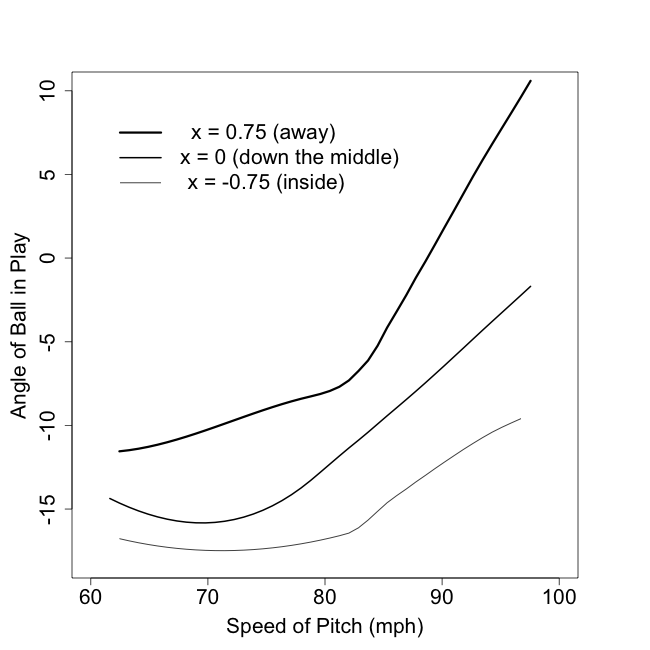
| F/X Visualizations | July 03, 2009 |
Last week I looked at the horizontal angle of a ball in play as a function of the location in the zone where it was hit. Although there is some trend for lower pitches to be pulled more, most of the trend is dictated by the horizontal location of the pitch. As expected inside pitches tend to be hit to the pull field and outside pitches more to the opposite field.
Below I reproduce the trend for just the horizontal location. I found the average angle of a ball in play as a function of the horizontal location of the pitch. The center of the strike zone is 0 and negative numbers indicate pitches that are inside to right hand batters and positive numbers outside. The strike zone extends from -1 (inside edge to a RHB ) to 1 (outside edge to a RHB). The angle of a ball in play follows the -45/0/45 convention (-45 is the third base line, 0 2nd base and 45 the first base line), so negative numbers indicate the pull field for a righty.

Starting away and moving towards the batter more and more balls are pulled, with the trend slowing and stopping at about the inside edge of the plate. Here you can see the overall pull tendency. At x=0, the middle of the plate, the average ball is hit to about 7.5° to the pull field and at x=1, the outside edge of the plate, the average ball is hit right up the middle.
I was interested in how this varied by pitch type. I expected that slower pitches would be pulled more, as hitter have more time to 'get around' on such pitches.

The results confirm our expectations. The slower a pitch type the more it is pulled, so that through much of the strike zone the average curveball or changeup is pulled 10° more than the average fastball in the same horizontal location. This shows part of the danger of coming inside with breaking and off-speed pitches. These pitches, if they are hit, will tend to be pulled heavily, which is where most hitters have the greatest power.
I also wanted to see how much speed affected pull, regardless of pitch type. Here I plot the average angle of a ball in play by pitch speed for three horizontal locations, away (but in the zone), down the middle and inside (but in the zone).

The effect of pitch speed is strong, nonlinear and interacts with location. So for inside pitches there is not much effect of speed, the pull rate of a very slow and very fast pitch are not that far off. Similarly there is not a lot of difference in the pull rate of very slow pitches across location, they are all pulled heavily. But outside pitches are strongly affected by pitch speed, with slow ones being pulled and fast ones going to the opposite field. And very fast pitches are strongly influenced by location, with inside ones being pulled and outside ones going to the opposite field.
The results here are not that surprising, but nicely confirm long-held baseball expectations.
Comments
I love this!
Posted by: jeff at July 3, 2009 1:56 PM
This is great stuff, thanks Dave.
Posted by: Harry Pavlidis at July 3, 2009 5:15 PM
BRAVO!!
Posted by: Luis Venitucci at July 5, 2009 7:16 AM
Thanks for the kind words guys.
Posted by: Dave Allen at July 6, 2009 7:07 AM
Balls on the inside corner are often pulled foul. I suspect that's why you're seeing some issues on the inside corner. I wonder how foul balls are impacting all three of these graphs...
Posted by: BenJ at July 7, 2009 1:04 PM